SUPER ALESTE
( Space Megaforce )
|
|
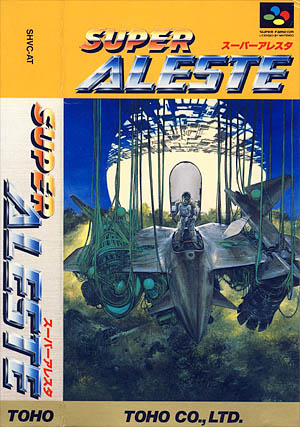
|

|
|
スーパーアレスタ
©1992 Toho Co.,LTD/Compile
Release: 1992-04-28 (¥8700)
Cartridge SHVC-AT
Shooter / Vertical


|
Released in America as
SPACE MEGAFORCE
( SNS-AT-USA )
|


|
Released in Europe as
SUPER ALESTE
( SNSP-AT-XXX )
|
|
Super Aleste is an intense vertical shooter by Compile and,
as the name so aptly implies, is part of the classic and critically acclaimed
"Aleste" series. In the year 2048 AD, a strange giant sphere appears
from the depths of space and starts attacking Earth cities. It eventually
stops in South America, over the Amazon jungle, where it starts building a
giant floating city. The Earth Allied Forces decide to launch a counterattack
and to deploy their most priced fighter - the 'Aleste' - to eliminate
the invader. But the fighter is quickly overwhelmed by a swarm of phenomenal
power and fails in its mission. Although in a desperate situation, the Earth
Forces don't surrender and they begin the construction of the 'Super Aleste'.
The new elite pilot Raz and his female alien co-pilot Thi are now on
a suicide mission to destroy the sphere and thus to put an end to the invasion.
The Super Aleste fighter is packed with serious firepower and no less than
eight different weapons can be equipped (such as homing missiles,
guided options, lasers or multi-shots). Additionally,
each weapon can be upgraded to a maximum of six times (by collecting orange
orbs or green weapon-pods) and all have two different modes of action that can
be switched at any time during gameplay. Beside, the power upgrades double as
a shield and the active weapon's power downgrades each time the fighter
receives a hit, and at zero the Super Aleste goes to oblivion. Finally,
super-bombs are of course available and used to wipe out most of the enemies
on screen in case of a sudden emergency. Super Aleste consists of
twelve levels (four are bonus stages) and also includes a 'short'
option which acts as an intense 'score attack' mode.
|
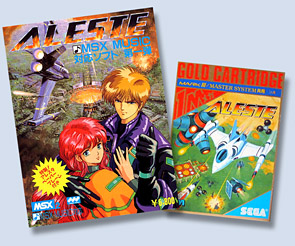 Aleste is certainly one of the few names most associated with
the prolific, and sadly defunct, video game company Compile
(the other being the excellent 'Puyo Puyo' puzzle series). The
first Aleste was released in 1988 for the MSX 2 and
Sega's Master System (the Master System
version is also known as 'Power Strike' in the rest of the world).
A pseudo-sequel called Power Strike II was released for the
Master System in 1993 (only in Europe), but it is not really
related to the Aleste series (the game takes place in the early 1930s,
in Italy, right after the great depression). Anyway, back to
Aleste - the original game shares a lot in common with
Zanac, another
vertical shooter by Compile and originally released in 1986 for
the MSX and Famicom Disk system. Many players consider
Aleste as a sequel to the excellent Zanac, and this may
not be too far from the truth as they both feature a space theme, a fast and frantic gameplay,
as well as a difficulty level that automatically adapts to the player's
skill level!
Aleste is certainly one of the few names most associated with
the prolific, and sadly defunct, video game company Compile
(the other being the excellent 'Puyo Puyo' puzzle series). The
first Aleste was released in 1988 for the MSX 2 and
Sega's Master System (the Master System
version is also known as 'Power Strike' in the rest of the world).
A pseudo-sequel called Power Strike II was released for the
Master System in 1993 (only in Europe), but it is not really
related to the Aleste series (the game takes place in the early 1930s,
in Italy, right after the great depression). Anyway, back to
Aleste - the original game shares a lot in common with
Zanac, another
vertical shooter by Compile and originally released in 1986 for
the MSX and Famicom Disk system. Many players consider
Aleste as a sequel to the excellent Zanac, and this may
not be too far from the truth as they both feature a space theme, a fast and frantic gameplay,
as well as a difficulty level that automatically adapts to the player's
skill level!
A sequel to Aleste,
simply called 'Aleste 2', followed in 1989 for the MSX 2.
Aleste Gaiden was also released for the MSX 2 the same
year and, I believe, was only available as part of Compile's disk Magazine Disc
Station and included in the Autumn 1989 edition. However, Gaiden
features noticeably different design and gameplay
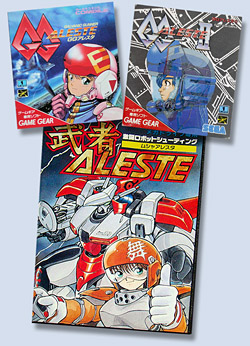 mechanics. Apparently, both sequels were exclusively released in Japan
and Aleste Gaiden stands out for many interesting reasons - it
actually introduced robotic samurai armors and a distinct medieval Japan
theme to the series, which will later be at the heart of Compile's
Musha spin-off series (more on this later). Super Aleste
followed in 1992 for the Super Famicom (version tested here) as
well as two other Game Gear games, namely GG Aleste (1991)
and GG Aleste 2 (1993). Interestingly, GG Aleste 2 was
renamed Power Strike II in the west, but it is in no way related
to Power Strike II released for the Master System in 1993!
As aforementioned, the Aleste series somewhat branched out with
Musha Aleste (aka M.U.S.H.A in the US) released for the
Sega Megadrive in 1990. Compile dropped the science fiction
theme introduced by the early games in the series and borrowed instead
elements from Japanese feudal history and folklore, such as giant stone
castles, mechanical beasts, ancient demons and samurai warriors. A sequel
followed for the Sega CD in 1993 (aka Robo Aleste in the US).
Interestingly, another game released for the PC Engine Super CDRom
shares a lot in common with Musha -
Seirei Senshi Spriggan
was released in 1991 and shows incredibly obvious similarities with
Musha Aleste. Although the game was published by Naxat Soft,
it was indeed developed by Compile. The same applies to the excellent
Gunhed released for
the PC Engine in 1989, and which shares a lot in common with
Super Aleste!
mechanics. Apparently, both sequels were exclusively released in Japan
and Aleste Gaiden stands out for many interesting reasons - it
actually introduced robotic samurai armors and a distinct medieval Japan
theme to the series, which will later be at the heart of Compile's
Musha spin-off series (more on this later). Super Aleste
followed in 1992 for the Super Famicom (version tested here) as
well as two other Game Gear games, namely GG Aleste (1991)
and GG Aleste 2 (1993). Interestingly, GG Aleste 2 was
renamed Power Strike II in the west, but it is in no way related
to Power Strike II released for the Master System in 1993!
As aforementioned, the Aleste series somewhat branched out with
Musha Aleste (aka M.U.S.H.A in the US) released for the
Sega Megadrive in 1990. Compile dropped the science fiction
theme introduced by the early games in the series and borrowed instead
elements from Japanese feudal history and folklore, such as giant stone
castles, mechanical beasts, ancient demons and samurai warriors. A sequel
followed for the Sega CD in 1993 (aka Robo Aleste in the US).
Interestingly, another game released for the PC Engine Super CDRom
shares a lot in common with Musha -
Seirei Senshi Spriggan
was released in 1991 and shows incredibly obvious similarities with
Musha Aleste. Although the game was published by Naxat Soft,
it was indeed developed by Compile. The same applies to the excellent
Gunhed released for
the PC Engine in 1989, and which shares a lot in common with
Super Aleste!
|
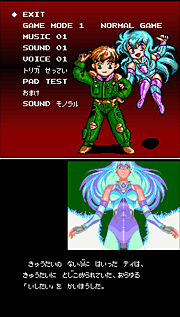 There are a couple of interesting differences between the original
Japanese game and the western releases. Particularly obvious is
the boot-up screen, although the Japanese version doesn't have any, the
American release starts with a copyright screen and a digitized voice that
says the name of the game ("Space Megaforce!") - while the European version says
"Presented by Toho". Another surprising difference is the omission
of all references to the anime-style characters seen in the original
game - both the pilot and the female co-pilot were removed from the option
and game over screens, as well as the introduction and end sequences (pictures on the right).
As a side note, the Japanese end sequence also shows that Thi (the co-pilot)
plays an important role in defeating the alien invader and this part was completely
removed from the western release... The story was also heavily edited, as well as
the name of the various areas and bosses. Finally, the music tracks for the bonus
stages (levels 3, 6, 9 and 10) were swapped around and one track was entirely
removed (well, this track does sound awfully close to several New Order's
hit songs, such as 'The Perfect Kiss' or 'Fine Time', and this
potential copyright infringement may explain the removal). Finally, the voice
message played each time the player collects a power-up was re-recorded for the
western releases and arguably sounds better.
There are a couple of interesting differences between the original
Japanese game and the western releases. Particularly obvious is
the boot-up screen, although the Japanese version doesn't have any, the
American release starts with a copyright screen and a digitized voice that
says the name of the game ("Space Megaforce!") - while the European version says
"Presented by Toho". Another surprising difference is the omission
of all references to the anime-style characters seen in the original
game - both the pilot and the female co-pilot were removed from the option
and game over screens, as well as the introduction and end sequences (pictures on the right).
As a side note, the Japanese end sequence also shows that Thi (the co-pilot)
plays an important role in defeating the alien invader and this part was completely
removed from the western release... The story was also heavily edited, as well as
the name of the various areas and bosses. Finally, the music tracks for the bonus
stages (levels 3, 6, 9 and 10) were swapped around and one track was entirely
removed (well, this track does sound awfully close to several New Order's
hit songs, such as 'The Perfect Kiss' or 'Fine Time', and this
potential copyright infringement may explain the removal). Finally, the voice
message played each time the player collects a power-up was re-recorded for the
western releases and arguably sounds better.
|
|
A patch was released by Frank Hugues that unlocks the game
original debug mode. This patch adds several interesting options, such as
invincibility, stage select, skip ahead to the end credits, a graphic viewer
as well as various options to modify weapons, lives or bombs during gameplay.
|
Teaser text from the American version:
A super mid-air battle! Do you want
to experience a high speed shooting
packed with excitement?
"Space Megaforce". The game's thrilling speed is its
most attractive feature. The enemy movements are
fast. Your shots and the enemies' shots are fast.
Finally, the scrolling is fast. The screen filled with
battle action just overflows with high speed shooting
excitement. On top of that there is the Shot Control
System operated with the "R" button. You can attack
the enemy in a multitude of ways with a weapon
using this system. Naturally, the features of the
Super NES such as rotations, enlarging, and shrinking
functions are used to their fullest and huge enemies
never before possible are packed into this exciting
MEGA game!
|
Game Staff (Copied from the end credits) :
|
STAFF
Executive Producers
Akira Kobayashi
Moo Niitani
Producers
Junichi Tsunoda
Masato Takeno
Taka Tanida
|
|
Programmer
Jemini Hirono
Graphic Designers
Janus Teramoto
kerol Watanabe
Itoh
Koshio
Sawa
Ohnishi
|
|
Sound Designers
Takeuchi
Nagao
Katsumi Tanaka
Game Designer
Jemini Hirono
|
|
Special Thanks to
Katsuji Suenaga
Matsuoka
&
Compile Staff
(c)1992 TOHO Co.,Ltd./Compile
|
|
O
M
A
K
E
|
|
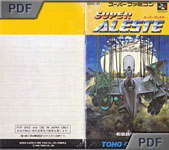
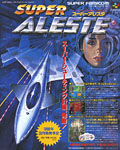
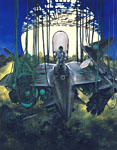
|
|
|
Click on picture to enlarge |
S
E
C
R
E
T
S
|
|
Respawning in Super Aleste:
 One aspect of Super Aleste can be confusing at first. When you
die, you are sometimes respawed at the last checkpoint, and other times you can
continue at the location where you died. Here is how this works - as you play,
you accumulate 'continue' ships (symbolized by a gold/yellow ship in your stock
of ships, bottom/right of the screen - see picture on the right). Although dying generally sends you back to
the last checkpoint, a 'continue ship' allows you to continue where you died.
The mechanism that increases the continue ships is not really clear though - it
is either based on score or the amount of enemy killed.
One aspect of Super Aleste can be confusing at first. When you
die, you are sometimes respawed at the last checkpoint, and other times you can
continue at the location where you died. Here is how this works - as you play,
you accumulate 'continue' ships (symbolized by a gold/yellow ship in your stock
of ships, bottom/right of the screen - see picture on the right). Although dying generally sends you back to
the last checkpoint, a 'continue ship' allows you to continue where you died.
The mechanism that increases the continue ships is not really clear though - it
is either based on score or the amount of enemy killed.
|
|
Ending screens:
The Japanese version of the game has several exclusive ending screens
(one for each difficulty level!). At the end of the staff roll, press
L and R and a new screen should appear. Here are
two of the screens (Normal and Hard difficutly):
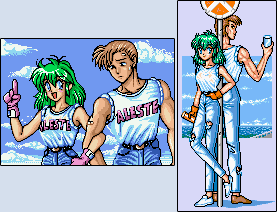
|
|
|
|
LK

|
|
Add your Pov here !
|
P
O
V
s
|
|
Super Aleste is an incredible game and probably the best vertical
shooter available for the Super Famicom system. Graphics are superb
with highly detailed sprites and awesome visual effects (the second level's
space station is breathtaking!). Then the game follows all the Compile's
shooting traditions by the book - so be ready for a fast, intense and
breathtaking experience (the game does really remind me of Gunhed for
the PC Engine). The screen is always swarming with enemy ships, bullets
and the arsenal of upgradable weaponry at your disposal is probably the most
destructive I have ever seen in the shooter. And all of this with no noticeable
slowdowns! Fans of other Compile shooters will have a mild feeling of
déja-vu but will feel right at home! Some explosions even sound like
the ones found in Gunhed for the PC Engine and the overall
difficulty level (but this is just a guess) seems to adjust itself to your
firepower like in the excellent Zanac. The game may not please all
shooter fans though and the constant frenzied action may not suit everyone...
some levels can also be quite long and repetitive. But all in all,
Super Aleste is a gorgeous 'tour de force' and an unbelievable game.
A brilliant masterpiece that deserves the "SUPER" prefix, unlike others.
|
|
|
|